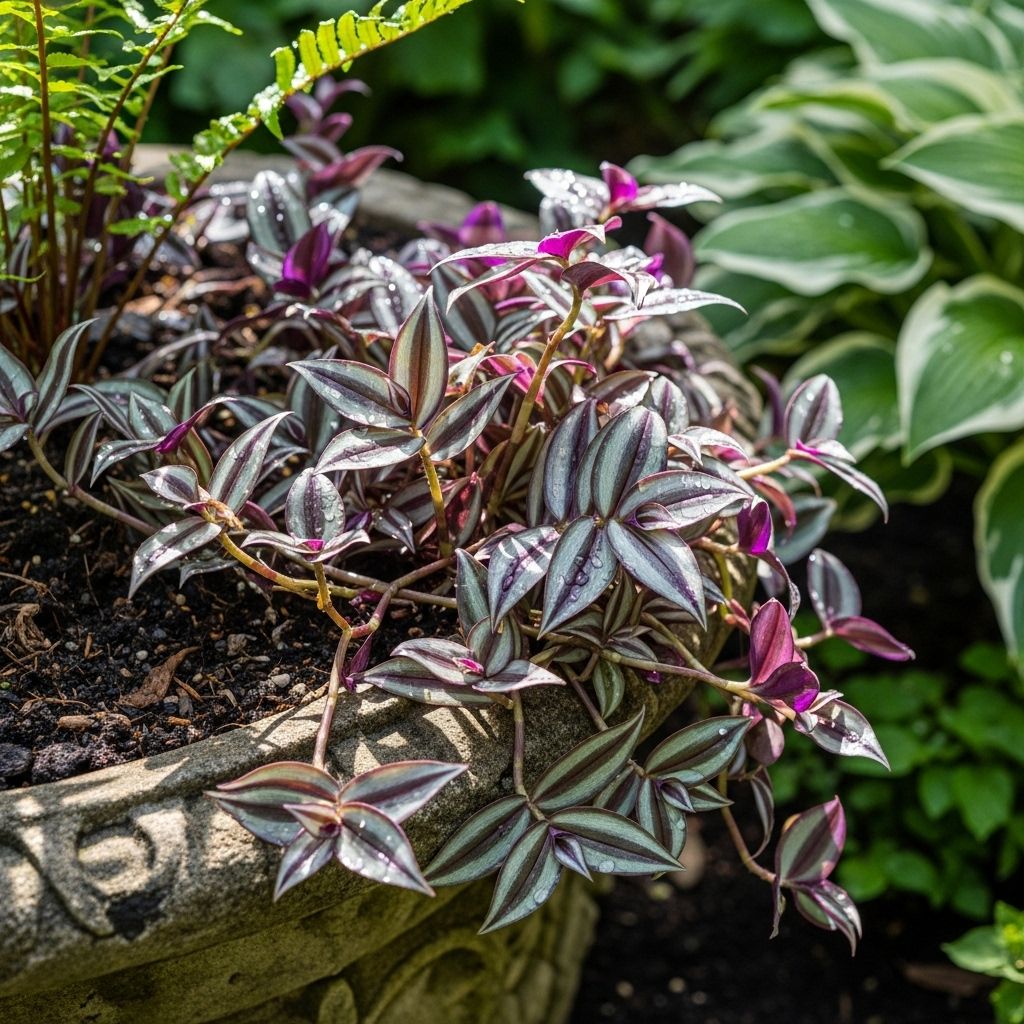How to Grow Inch Plant Outdoors: A Complete Gardener’s Guide
Colorful stems spill over edges creating low-maintenance borders with year-round interest.

Image: HearthJunction Design Team
How to Grow Inch Plant Outdoors
Can you successfully grow inch plant outdoors? The answer is an emphatic yes. While inch plants (Tradescantia species) are commonly known as houseplants, they are well-suited for outdoor cultivation in many climates. With a few strategic care tips and attention to their specific needs, you can enjoy lush, colorful foliage in your outdoor garden. This comprehensive guide walks you through everything you need to know about growing inch plant outdoors, from temperature and climate considerations to propagation and pest management.
Table of Contents
- Introduction to Outdoor Inch Plant Cultivation
- Temperature and Climate Considerations
- Choosing the Right Outdoor Location
- Soil Requirements and Preparation
- Watering Needs and Best Practices
- Fertilizing for Healthy Growth
- Pruning and Maintenance
- Propagation Techniques
- Pests and Disease Management
- Overwintering and Seasonal Adjustments
- Container Gardening with Inch Plant Outdoors
- Frequently Asked Questions (FAQs)
Introduction to Outdoor Inch Plant Cultivation
Tradescantia—commonly called inch plant, wandering Jew, or spiderwort—is beloved for its vibrant foliage and adaptability. Most garden enthusiasts grow inch plant indoors, but few realize its outdoor potential, especially in warm and temperate zones. Outdoors, inch plants spread to create lush, trailing mounds or cascading groundcovers. Their resilience and visual appeal make them an excellent choice for gardeners seeking low-maintenance color and texture in borders, containers, or groundcover plantings. Let’s explore the essential considerations for successful outdoor cultivation.
Temperature and Climate Considerations
Inch plant thrives in climates where temperatures stay between 50-80°F (10-27°C) for most of the year. During winter, a dip to about 45°F (7°C) is tolerable for short periods, but extended cold can be fatal. In regions prone to sudden frosts, gardeners should be ready to offer protection—like a cold frame or woven cloth covering—which can provide a few extra degrees of warmth in a pinch. When summer heat pushes past 90°F (32°C), inch plants benefit from more frequent watering and partial shade to prevent leaf scorch.
- Ideal temperature range: 50–80°F (10–27°C)
- Short-term cold tolerance: Down to 45°F (7°C)
- Frost protection: Use cold frames or fabric coverings in emergencies
- Heat stress: Above 90°F (32°C), increase watering and shade
- General light requirement: Bright, but partially-shaded environment
Choosing the Right Outdoor Location
Position inch plants where they receive filtered sunlight or part shade. A site that gets morning light and afternoon shade is ideal, as direct, intense sun can bleach and scorch the leaves, whereas too much shade can reduce the intensity of their signature colors. Inch plants make excellent groundcovers beneath larger shrubs or trees, in hanging baskets on porches, or as border edgings along walkways and garden beds.
- Bright, indirect light is optimal
- Protect from harsh, direct midday sun
- Good airflow helps reduce fungal problems
- Consider elevation—avoid low, soggy spots
Soil Requirements and Preparation
Inch plants prefer well-draining, loose soil with moderate fertility. Heavy clay or soggy soils can cause root rot—a common Tradescantia complaint. Amend the planting area with compost or leaf mold to improve drainage and enhance soil structure. If growing in pots, use a high-quality, all-purpose potting mix with added perlite or sand for drainage. The pH should be slightly acidic to neutral (6.0–7.0) for best results.
- Use loose, well-draining soil
- Amend garden beds with compost or leaf mold
- Add perlite or coarse sand for improved drainage
- Ideal soil pH: 6.0–7.0
Watering Needs and Best Practices
Consistent moisture is key for lush inch plant growth, but avoid letting the soil become waterlogged. Inch plants want their root zones to be regularly damp but not soggy. During the hottest months or dry spells, increase watering frequency to compensate for evaporation. Early morning is the best time to water, delivering moisture to the roots while allowing leaves to dry quickly and avoid fungal issues.
- Water when the top inch of soil feels dry
- Water deeply to reach the root zone
- Ensure containers and beds have good drainage
- Reduce watering frequency in cool weather
Fertilizing for Healthy Growth
Outdoor inch plants benefit from a balanced, slow-release fertilizer applied at the start of the growing season. Too much fertilizer can cause leggy growth and fewer leaves. Compost can be used instead for organic gardens and will provide gentle, consistent nutrients throughout the season. Avoid high-nitrogen fertilizers, as they encourage foliage growth at the expense of color intensity and overall vigor.
- Apply balanced, slow-release fertilizer in spring
- Consider compost for organic nutrition
- Do not over-fertilize; less is more
- Supplement feed every 6–8 weeks as needed
Pruning and Maintenance
Regular pruning keeps inch plants compact, bushy, and vibrant. Pinch or snip back long, leggy stems to stimulate branching. Remove spent or damaged leaves promptly to improve aesthetics and prevent disease. Inch plants grow quickly; periodic trimming will keep them looking their best and encourage denser growth. Prunings can be used for propagation or composted.
- Pinch back stems to encourage bushiness
- Remove dead, yellow, or damaged foliage
- Control spread in the garden by trimming borders
- Prune regularly during active growth season
Propagation Techniques
Tradescantia is famously easy to propagate. The simplest method is to take stem cuttings 4–6 inches long and root them in water or moist soil. Inch plants can also root directly in garden beds if pruned stems are left in contact with the ground. For best results, take cuttings in the spring or early summer when the plant is actively growing. Rooted cuttings can then be planted as new starts or shared with friends.
- Cut 4–6 inch healthy stem tips
- Remove leaves from the lower portion of the cutting
- Place cuttings in water or directly in moist soil
- Roots usually develop in 1–2 weeks
- Transplant to permanent location after rooting
Pests and Disease Management
Inch plants are generally low-maintenance and pest resistant, but a few issues can occur outdoors. Common pests include spider mites, aphids, and mealybugs, especially during dry spells. Overly wet or crowded conditions can lead to fungal problems such as leaf spot or stem rot. Good airflow, prompt removal of affected foliage, and occasional hosing off of pests can keep problems at bay.
- Inspect regularly for spider mites, aphids, and mealybugs
- Remove affected leaves promptly
- Use insecticidal soap for persistent pest problems
- Improve airflow to reduce fungal disease risk
- Water at the soil level to avoid wetting leaves
Overwintering and Seasonal Adjustments
Inch plants can’t tolerate prolonged freezing conditions. In regions with cold winters, consider growing Tradescantia in containers that can be moved indoors before frost. Alternatively, take cuttings at the end of the season and overwinter them inside, then replant in spring. Outdoor plants should be mulched lightly in fall to protect roots from short cold snaps but brought inside or covered when hard frost threatens.
- Move containers indoors before first frost
- Take cuttings to overwinter inside as insurance
- Mulch garden plants to protect roots in mild winters
- Cover plants with fabric during unexpected cold nights
Container Gardening with Inch Plant Outdoors
Inch plant excels in containers, making it easy to adjust for climate and create stunning patio displays. Container-grown inch plants benefit from excellent drainage and the ability to move them to ideal light or sheltered spots as needed. Hanging baskets, window boxes, and decorative pots all showcase trailing Tradescantia to great effect. Ensure pots have ample drainage holes and avoid waterlogged conditions. Rotate pots occasionally for even growth and to avoid one-sided stretching toward the sun.
- Use pots with multiple drainage holes
- Choose a lightweight, well-draining mix
- Water more frequently in hot, windy weather
- Rotate containers for even sun exposure
- Elevate pots on stands to improve airflow
Frequently Asked Questions (FAQs)
Q: Can I plant inch plant directly in garden soil outdoors?
A: Yes, as long as the soil drains well and doesn’t stay soggy. Amend heavy or compacted soil with compost to ensure roots stay healthy.
Q: How much sunlight does outdoor inch plant need?
A: Aim for bright, indirect or filtered light. A little morning sun with afternoon shade works best, especially in hot climates.
Q: Is inch plant invasive outdoors?
A: While Tradescantia spreads quickly, it’s rarely aggressive enough to be considered invasive in most gardens. Regular pruning keeps it in check.
Q: How do I keep my inch plant colorful outdoors?
A: Provide bright light, avoid over-fertilizing, and prune regularly. Stress from poor soil or inconsistent watering can dull leaf color.
Q: Will inch plant survive freezing temperatures?
A: Tradescantia can handle brief dips to 45°F (7°C) but will be killed by a hard frost. Bring plants indoors or protect them if a freeze is expected.
Q: Can I propagate inch plant outdoors?
A: Absolutely. Take stem cuttings in spring or summer and root them directly into moist garden soil or containers outdoors.
Conclusion
Growing inch plant outdoors brings lush, colorful foliage and easy-care beauty to any garden space. With the right temperature, site, soil, and care, Tradescantia thrives as a groundcover, container accent, or hanging basket showstopper. Keep an eye on temperature extremes, prune for shape and health, and enjoy the year-round appeal of this adaptable, beginner-friendly plant. Whether you’re landscaping a border or just adding flair to your patio, the inch plant is a rewarding and forgiving choice for gardeners of all skill levels.
References
Read full bio of Srija Burman












